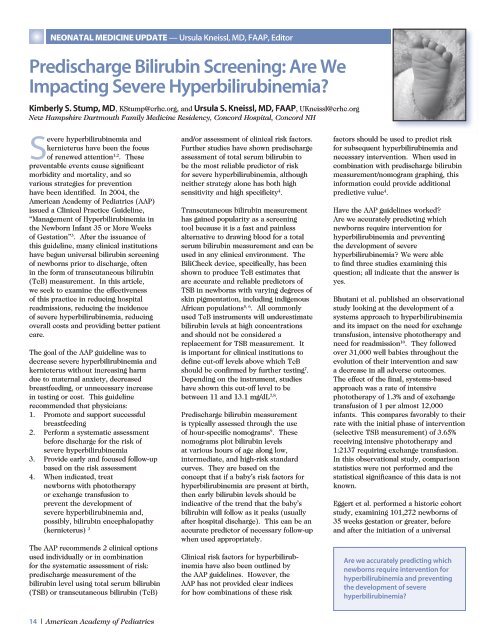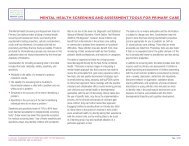Susan Wu, MD, FAAP, Editor - American Academy of Pediatrics
Susan Wu, MD, FAAP, Editor - American Academy of Pediatrics
Susan Wu, MD, FAAP, Editor - American Academy of Pediatrics
Create successful ePaper yourself
Turn your PDF publications into a flip-book with our unique Google optimized e-Paper software.
Severe hyperbilirubinemia and<br />
kernicterus have been the focus<br />
<strong>of</strong> renewed attention 1,2 . These<br />
preventable events cause significant<br />
morbidity and mortality, and so<br />
various strategies for prevention<br />
have been identified. In 2004, the<br />
<strong>American</strong> <strong>Academy</strong> <strong>of</strong> <strong>Pediatrics</strong> (AAP)<br />
issued a Clinical Practice Guideline,<br />
“Management <strong>of</strong> Hyperbilirubinemia in<br />
the Newborn Infant 35 or More Weeks<br />
<strong>of</strong> Gestation” 3 . After the issuance <strong>of</strong><br />
this guideline, many clinical institutions<br />
have begun universal bilirubin screening<br />
<strong>of</strong> newborns prior to discharge, <strong>of</strong>ten<br />
in the form <strong>of</strong> transcutaneous bilirubin<br />
(TcB) measurement. In this article,<br />
we seek to examine the effectiveness<br />
<strong>of</strong> this practice in reducing hospital<br />
readmissions, reducing the incidence<br />
<strong>of</strong> severe hyperbilirubinemia, reducing<br />
overall costs and providing better patient<br />
care.<br />
The goal <strong>of</strong> the AAP guideline was to<br />
decrease severe hyperbilirubinemia and<br />
kernicterus without increasing harm<br />
due to maternal anxiety, decreased<br />
breastfeeding, or unnecessary increase<br />
in testing or cost. This guideline<br />
recommended that physicians:<br />
1. Promote and support successful<br />
breastfeeding<br />
2.<br />
3.<br />
4.<br />
NeoNataL meDiCiNe UPDate — Ursula Kneissl, <strong>MD</strong>, <strong>FAAP</strong>, <strong>Editor</strong><br />
Predischarge Bilirubin Screening: Are We<br />
Impacting Severe Hyperbilirubinemia?<br />
Kimberly S. Stump, <strong>MD</strong>, KStump@crhc.org, and Ursula S. Kneissl, <strong>MD</strong>, <strong>FAAP</strong>, UKneissl@crhc.org<br />
New Hampshire Dartmouth Family Medicine Residency, Concord Hospital, Concord NH<br />
Perform a systematic assessment<br />
before discharge for the risk <strong>of</strong><br />
severe hyperbilirubinemia<br />
Provide early and focused follow-up<br />
based on the risk assessment<br />
When indicated, treat<br />
newborns with phototherapy<br />
or exchange transfusion to<br />
prevent the development <strong>of</strong><br />
severe hyperbilirubinemia and,<br />
possibly, bilirubin encephalopathy<br />
(kernicterus) 3<br />
The AAP recommends 2 clinical options<br />
used individually or in combination<br />
for the systematic assessment <strong>of</strong> risk:<br />
predischarge measurement <strong>of</strong> the<br />
bilirubin level using total serum bilirubin<br />
(TSB) or transcutaneous bilirubin (TcB)<br />
14 | <strong>American</strong> <strong>Academy</strong> <strong>of</strong> <strong>Pediatrics</strong><br />
and/or assessment <strong>of</strong> clinical risk factors.<br />
Further studies have shown predischarge<br />
assessment <strong>of</strong> total serum bilirubin to<br />
be the most reliable predictor <strong>of</strong> risk<br />
for severe hyperbilirubinemia, although<br />
neither strategy alone has both high<br />
sensitivity and high specificity 4 .<br />
Transcutaneous bilirubin measurement<br />
has gained popularity as a screening<br />
tool because it is a fast and painless<br />
alternative to drawing blood for a total<br />
serum bilirubin measurement and can be<br />
used in any clinical environment. The<br />
BiliCheck device, specifically, has been<br />
shown to produce TcB estimates that<br />
are accurate and reliable predictors <strong>of</strong><br />
TSB in newborns with varying degrees <strong>of</strong><br />
skin pigmentation, including indigenous<br />
African populations 5, 6 . All commonly<br />
used TcB instruments will underestimate<br />
bilirubin levels at high concentrations<br />
and should not be considered a<br />
replacement for TSB measurement. It<br />
is important for clinical institutions to<br />
define cut-<strong>of</strong>f levels above which TcB<br />
should be confirmed by further testing 7 .<br />
Depending on the instrument, studies<br />
have shown this cut-<strong>of</strong>f level to be<br />
between 11 and 13.1 mg/dL 7,8 .<br />
Predischarge bilirubin measurement<br />
is typically assessed through the use<br />
<strong>of</strong> hour-specific nomograms 9 . These<br />
nomograms plot bilirubin levels<br />
at various hours <strong>of</strong> age along low,<br />
intermediate, and high-risk standard<br />
curves. They are based on the<br />
concept that if a baby’s risk factors for<br />
hyperbilirubinemia are present at birth,<br />
then early bilirubin levels should be<br />
indicative <strong>of</strong> the trend that the baby’s<br />
bilirubin will follow as it peaks (usually<br />
after hospital discharge). This can be an<br />
accurate predictor <strong>of</strong> necessary follow-up<br />
when used appropriately.<br />
Clinical risk factors for hyperbilirubinemia<br />
have also been outlined by<br />
the AAP guidelines. However, the<br />
AAP has not provided clear indices<br />
for how combinations <strong>of</strong> these risk<br />
factors should be used to predict risk<br />
for subsequent hyperbilirubinemia and<br />
necessary intervention. When used in<br />
combination with predischarge bilirubin<br />
measurement/nomogram graphing, this<br />
information could provide additional<br />
predictive value 4 .<br />
Have the AAP guidelines worked?<br />
Are we accurately predicting which<br />
newborns require intervention for<br />
hyperbilirubinemia and preventing<br />
the development <strong>of</strong> severe<br />
hyperbilirubinemia? We were able<br />
to find three studies examining this<br />
question; all indicate that the answer is<br />
yes.<br />
Bhutani et al. published an observational<br />
study looking at the development <strong>of</strong> a<br />
systems approach to hyperbilirubinemia<br />
and its impact on the need for exchange<br />
transfusion, intensive phototherapy and<br />
need for readmission 10 . They followed<br />
over 31,000 well babies throughout the<br />
evolution <strong>of</strong> their intervention and saw<br />
a decrease in all adverse outcomes.<br />
The effect <strong>of</strong> the final, systems-based<br />
approach was a rate <strong>of</strong> intensive<br />
phototherapy <strong>of</strong> 1.3% and <strong>of</strong> exchange<br />
transfusion <strong>of</strong> 1 per almost 12,000<br />
infants. This compares favorably to their<br />
rate with the initial phase <strong>of</strong> intervention<br />
(selective TSB measurement) <strong>of</strong> 3.65%<br />
receiving intensive phototherapy and<br />
1:2137 requiring exchange transfusion.<br />
In this observational study, comparison<br />
statistics were not performed and the<br />
statistical significance <strong>of</strong> this data is not<br />
known.<br />
Eggert et al. performed a historic cohort<br />
study, examining 101,272 newborns <strong>of</strong><br />
35 weeks gestation or greater, before<br />
and after the initiation <strong>of</strong> a universal<br />
Are we accurately predicting which<br />
newborns require intervention for<br />
hyperbilirubinemia and preventing<br />
the development <strong>of</strong> severe<br />
hyperbilirubinemia?



